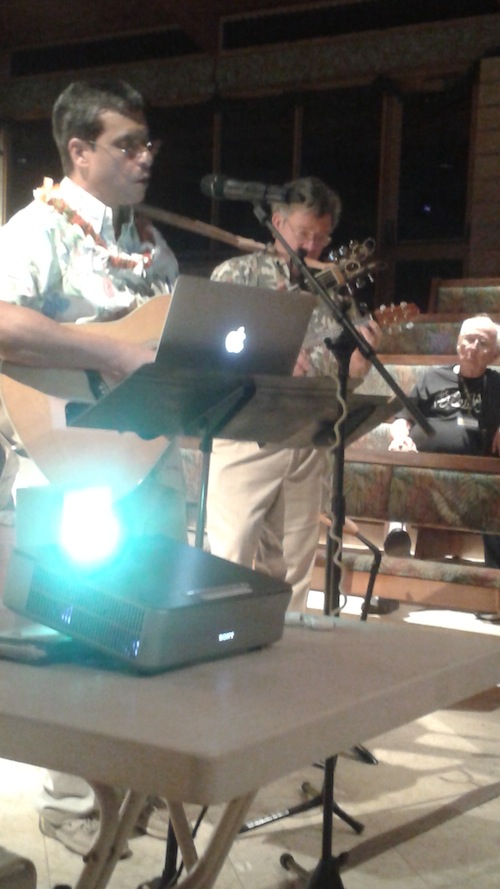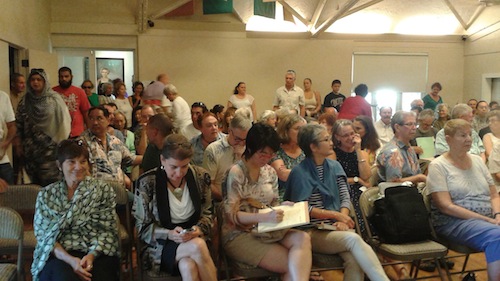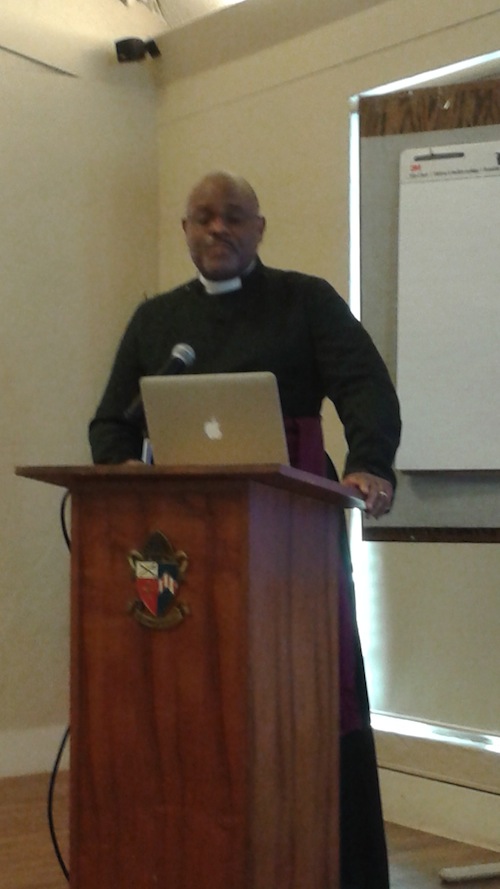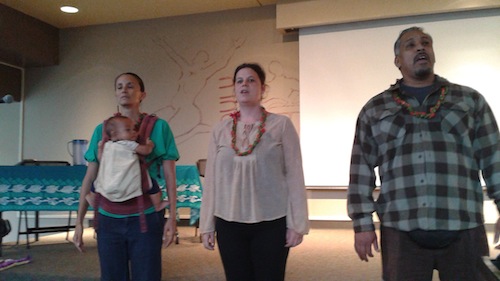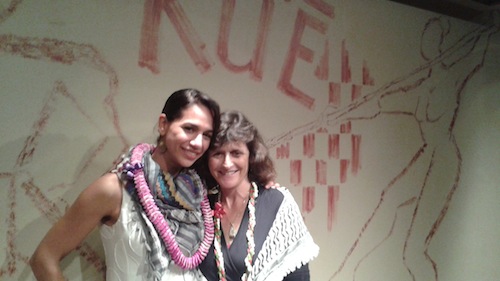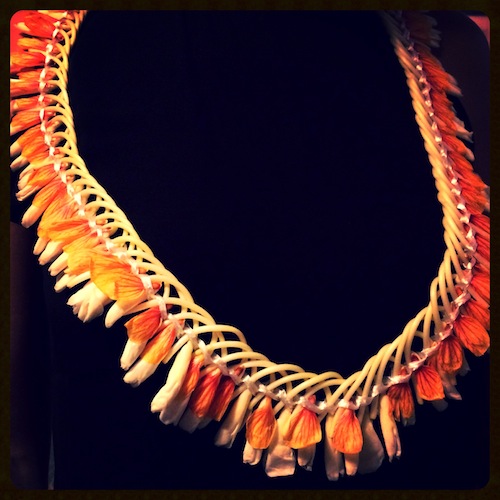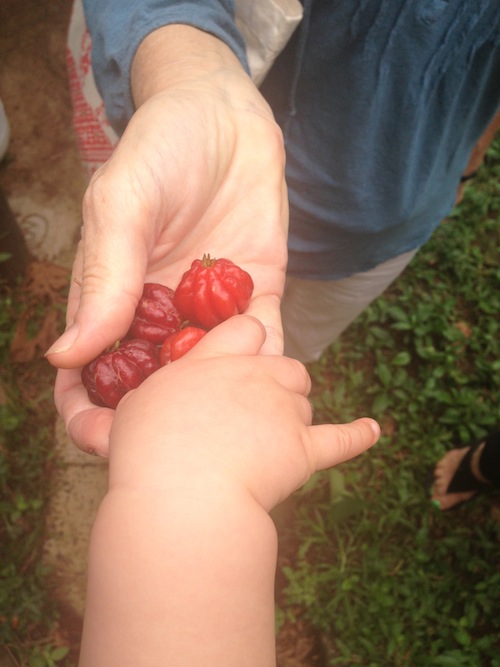In late November 2014, I had the honor of visiting the occupied Kingdom of Hawai’i as an invited guest. I prepared for the trip with ample readings J. Kehaulani Kaunaui both wrote and shared with me, along with book recommendations that my hostess, Cynthia Franklin, passed along. (It merits writing a separate article just about Cindy and her phenomenal skills as an organizer and her generosity as a friend. She is fire.) I thought my greatest challenge would be unraveling the competing independence paradigms, namely de-occupation and de-colonization, and understanding their relationship to indigenous nationhood. While we indeed delved into these issues, they were quickly eclipsed by something I could not prepare for: the island’s spirit.
It must sound silly to reduce the violent, military takeover of a sovereign nation, the exploitation of its lands and waters, and the marginalization of its people to a metaphysical sensation. However, this is not to make light of the situation. To the contrary, by centering that spirit, I am emphasizing the gravity of these ongoing crimes and the righteousness of the resistance to them.
The Kanaka Maoli, who today constitute twenty percent of Hawaii’s population, often express their relation to their lands with “aloha aina,” literally love for the land. Aloha, though neatly commodified to sell Hawai’i to tourists, represents a way of being deeply ingrained within native Hawaiian culture. It encompasses how you treat your neighbor, your family, how you maintain your relations with the elements that sustain life, and how you will to live. Aloha aina seems to translate neatly but is meant to capture a people’s sacred commitment to life, a way of life and a way of viewing life.
In my five hurried days that included three lectures, several interviews, and generous dinners, I admittedly only caught a glimpse of that spirit. Yet, that glimpse gripped me almost instantly and I found myself beginning my lectures with confessions about the impact of this spiritual knowledge and how it scales hyper-intellectual conversations to their proper size. I began with a discussion about my family’s journey of displacement and exile, about how I came to be a settler in North America, and what it meant to visit the occupied kingdom in solidarity. No one flinched at my openness. It could not have been more proper, especially following the welcoming songs or the Oli–the Hawaiian ceremonial chants—that preceded my remarks.
De-Tour: The People’s History of Hawai’i
It was with this openness and spiritual awareness that I embarked on the De-Tour or Sovereignty Tour with local leaders and s/heroes, Kyle Kajihiro and Aunty Terri Lee Keeko’olani. The tour provides a critical history of the island and its most well-known landmarks. We happened to go on the tour on Hawaii’s Independence Day. On 28 November 1843, the United Kingdom and France recognized Hawai’i as a sovereign state by treaty. Hawaii’s formal sovereignty is precisely what makes it so unique. There is no contestation that it is occupied.
Hawaii’s sugar oligarchy, represented by white American settlers, motivated the occupation. Seeking to remove the tariffs on their sugar exports to the United States, this oligarchy in collusion with the US Minister to Hawai’i, John L. Stevens, facilitated the landing of US Marines on Hawaiian shores to hold the Queen Lilioukalani hostage and take over the kingdom in 1893. US President Grover Cleveland refused to recognize the US military coup and takeover of Hawai’i and recommended restoration of the Queen. His efforts failed, and his successor, William McKinley, supported annexation despite fervent protest captured in petitions against annexation that were buried by colonial school curricula and only recently resurrected by Hawaiian scholar Noe Noe Silva. The United States formally annexed Hawai’i in 1898 although the annexation lacked legitimacy for being unilateral and not treaty based. It incorporated Hawai’i, and Alaska, into the United States in 1959.
In 1993, one hundred years following the takeover, the United States issued a formal apology to native Hawaiians for the takeover of the Kingdom and the annexation of public and government lands without compensation. But the US government did nothing to remedy the situation. Hawai’i remains vital to the United States for military and strategic reasons.
The United States has confiscated 1.8 million acres of the kingdom’s four million acres of land. It set aside a miniscule amount in trust for native Hawaiian benefit, measured by a distorting blood quantum, and uses the rest of that land for the expansion of bases or other military purposes. There are 118 military bases on Oahu alone. They take up twenty-six percent of the land or 230,000 acres.
Beyond its territorial dominance, the United States uses Hawaii’s strategic position to maintain control over its Western border. It does so from its Pacific Command (PacCom), also known as the head of the octopus or he`e for being the largest unified US command. It extends from the US western coast to the Indian Ocean and from Alaska and includes all of Antarctica—it stretches over fifty percent of the earth`s surface and includes forty-three countries. Pearl Harbor is part of this vast network and is the tip of the iceberg of the entrenchment of military-industrial complex in Hawai`i. It is so central to the economy that folks describe it as a necessary evil. The presence of military installations and retired personnel marks an elite demographic that shapes Hawai`i`s politics. This includes subsidized housing for military personnel to the tune of three thousand US dollars per month and private malls, grocery stores, schools, and golf courses. Often times these luxurious benefits juxtapose dilapidated housing complexes for native Hawaiians who live communally.
The Battle Over Water and Livelihoods
US occupation of Hawai`i has had a tremendous impact on the flow and distribution of water. Taro—a wetland root—has been a staple among bad for native Hawaiians. The emergence of sugar plantations overseen by American oligarchs necessitated the diversion of water from those wetlands to more arid landscapes severely undermining indigenous agricultural practices and livelihoods. Elite interests unjustly also altered the flow of water throughout all of the islands thus impacting socio-political relations among Hawaiians as well. When sugar was no longer as profitable, ruling oligarchs shifted their businesses to tourism. The original waterways have never been restored though this battle continues.
Brothers, Charles and Paul Reppun, have led several of these protracted battles. Together with their families, they oversee a sustainable farm on Oahu that we had the privilege and delight of visiting and tasting. Between 1913 and 1916, the Oahu Sugar Company built a ditch and diverted twenty-seven million gallons per day from the windward watersheds of the Koolau mountains to Oahu’s central plain to support sugar plantations. In 1995, the Oahu Sugar Company ceased its operations, thus sparking a legal battle to restore the streams and native stream life. The Reppuns, in coalition with other taro farmers and native Hawaiians led this battle. The Hawaiian Supreme Court twice vacated the Board of Water Supply’s (BWS) findings and recommendations citing their non-compliance with State Water Code and public trust principles. In 2006, the BWS issued a split decision that seems to reiterate its 1997 recommendations overturned by the Hawai’i Supreme Court in 2000. The BWS majority favors diverting the water for future yet-to-be-permitted uses like housing developments and tourist attractions. This is a battle between a way of life, livelihood, cultural practices, sacred sites on the one hand and lucrative development for private interests on the other. As Charlie explained to me, like all else, “farming is political.”
Hawaiians Seek Sovereignty
Despite their striking parallels to indigenous nations in North America and to Palestinians, Hawai’i is quite distinct. For one, settler-colonialism in Hawai’i does not seek to disappear and replace the native but rather to appropriate and commodify their cultural practices, land/sea-based livelihoods, and images. That is tied to the sovereignty movement, which does not seek to federal recognition as a nation with the benefits of semi-autonomy (think Native Americans and reservations) but rather seeks an end to US occupation and the restoration of national sovereignty. During the summer 2014, the Department of Interior held a series of hearing across the archipelago on this issue and this resistance to federal recognition organically emerged as a consensus. Positive unintended consequences.
What next for the Hawaiian movement? The recent DOI hearings revealed a new and organic consensus for independence. Questions remain however, whether that should be a process of diplomatic recognition at the United Nations and among European capitols (think Palestine’s efforts between 2011 and the present) or should it be a movement aimed at ending US colonization by placing Hawai’i on the United Nations list of Non-Self-Governing Territories? Should it be both? What it is the particular role of the Kanaka Maoli in the independence movement and post-independence? Should Hawaiians extricate themselves from a military-industrial economy and if so, how? What is the role of language restoration, environmental justice, and economic justice in these battles? These are all questions Hawaiians are grappling with daily and have been writing about brilliantly. I share a modest reading list below. I am honored that I have met several of these esteemed authors and kahunas.
Solidarity With Palestine
In the midst of their struggles–Hawaiians have stood in principled and fierce solidarity with Palestinians. Each of my talks was overwhelmingly attended and I was received as no less than a representative of a nation. A humbling and undeserved honor that painfully reminded me that had a vibrant Palestinian Liberation Organization (PLO) still existed, this may have been possible. In the course of our conversations, Hawaiians expressed that while they see parallels between their struggle and that of Palestinians, they recognize how different they are because they do not endure the violence of military occupation, apartheid, and all out warfare. MANA, the Movement for Aloha No Ka Aina, read this solidarity letter in protest of the war on Gaza at the closing event, which they originally read at a rally protesting a talk by Secretary John Kerry and the US support of Israel’s war on Gaza:
August 2014
Movement for Aloha no ka ʻĀina (MANA) is a movement-building organization, established to achieve independence from the United States and social justice in Hawai`i. Hawai`i has been under US occupation for over 120 years, an occupation that is illegal both under international law and US domestic law, a fact that the United States has yet to refute. We follow in the history of Aloha ‘Āina in Hawaiʻi, and in the tradition of peoples throughout the world who struggle for liberation, freedom, and justice.
Under US occupation, our people and land have suffered what some might consider a more "tender" violence than what we are currently witnessing in Gaza where the the most explicit of US-backed state violence is being wielded upon Palestinian families. Nonetheless, for the same reasons, for the economic exploitation of our land, the US has systematically repressed our Independence, oppressed Kanaka Maoli, tried to erase us from our land and from our culture and has and continues to drive us and our stories off our lands for housing developments, military expansion, and other corporate interests.
To rub salt into the wound, the US military uses our lands to prepare armies around the world to do to other people, what they have essentially done to us. It is both dehumanizing and humiliating to not have control of our own country, to not be able to determine whether our sacred ʻāina will produce food or whether she will be forced into the production of US wars.
We are both outraged and strengthened as we witness the Palestinians’ own commitment to struggle to maintain their ancestral connections to land and we are committed to continue to struggle in Hawai`i to liberate our ourselves and our lands toward the liberation of all victims of US empire.
They also gifted me with this letter and pair of earrings. And though it was addressed to me, it was meant for a nation on behalf of a nation.

I want to end by sharing the poem of Bryan Kamaoli Kuwada- someone I am honored to call a friend and a teacher. Bryan read this poem at the closing event on 1 December 2014 and it is worth sharing many times over. I am also sharing a YouTube clip of his recitation at a different event because watching it is a whole different experience.
To Ea: In Response to David Kahalemaile, August 12, 1871
By Bryan Kamaoli Kuwada
Ke ea o ka i‘a, he wai
Lu‘u a ea, lu‘u a ea
Breathe deep, O breath-stealing ocean
You offer much but exact a toll as well
Our friends and our land swallowed by your hungering mouth
Too many mistake your surging power for invulnerability
And your injuries wash up broken and rotting upon our shores
Yet your tattooed knees show that you too have been ignored
Sides heaving, coral ribcage expanding, contracting
Breathing, an exertion made difficult in this age
This era of disrespect, of not honoring reciprocity
And those closest to you are those who suffer
Until we rise again from your depths
Yearning, reaching, crying for ea
Ke ea o ke kanaka, he makani
Hali mai ka makani i ka hanu ea o ka honua
Wind called from our lungs
Anae leaping from the pali, two minutes at a time
Some lifted on the shoulders of the wind
Others clawing for breath as they fall
We are taught never to call them back
The wind returns, but they do not
Mouths stretched open until jaws crack
Used as fishhooks, drawing forth our connections from the sea
Circular and round, soft and untenable
Wind sweeps infinitely into night
‘O ke ea o ka honua, he kanaka
‘O au nō na‘e kāu kauwā
In your presence, I count by fours
Carrying a breath in each space between my fingers
Each palm drawn towards the ground
Called close by your fertility
Our noses touch
Nothing but the ea held in our manawa
Cartilage, skin, and bone connecting to rock, earth
And young, smooth stone
The hā of genealogical age passes between us
And I know the weight, the measure, the depth
Of my connection to you
Ke ea o ka moku, he hoeuli
‘O ka hōkū ho‘okele wa‘a ke a‘ā nei i ka lani
Familiar stars and swells etch a map in our aching bones
Remembered pain is how we find our way to you
Frenzied waves whip the ocean to a bitter froth
But we’ve never forgotten how to navigate
How to draw our fingers across the face of a passing wave
The sun strains as our sail, while birds lift our hulls
Koa has always grown on this sea, in our masts, our hulls, our hearts
Leaving only the question of crew
We accept only those who will step bravely into darkness
For we have the generations to light our way
Ke ea o ko Hawai‘i Pae ‘Āina, ‘o ia nō ka noho Aupuni ‘ana
E ka lāhui ē, ‘o kāu hana nui, e ui ē
They tell us that they have seen the wonders of Mānā
But it is only heat rippling on sand
And we are angry that they are pushing a mirage
There is no fucking bucket—
But we have always been crabs
Pai‘ea, Kapāpa‘iaheahe, Ka‘a‘amakualenalena
Holding fast to the stones, fighting against crashing waves
Each struggling breath between sets reaffirms our ea
And what they refuse to recognize
Is that when we yell, when we shout
We do it not in anger
But to reassure our ancestors
That we are still here
Reading Recommendations
Liliuokalani, Hawaii’s Story By Hawaii’s Queen. Honolulu: Mutual Publishing, 1990.
Goodyear-Kaopua, Noelani, Ikaika Hussey, and Erin Kahunawaika’ala Wright, eds. A Nation Rising: Hawaiian Movements for Life, Land, and Sovereignty. Durham: Duke University Press, 2014.
Yamashiro, Aiko and Noelani Goodyear-Kaopua, eds. The Value of Hawai’i 2: Ancestral Roots, Oceanic Visions. Hawai’i: Biographical Research Center, 2014.
Haunani Kay Trask, From a Native Daughter: Colonialism and Sovereignty in Hawai’i, Honolulu: University of Hawai’i Press, 1999.
Ku’e: Thirty Years of Land Struggles in Hawai’i, Text and captions by Haunani-Kay Trask, Photographic Essay by Ed Greevy. Honolulu: Mutual Publishing, 2004.
Tengan, Ty P. Kawika, Native Men Remade: Gender and Nation in Contemporary Hawai’i. Durham: Duke University Press, 2008.
Silva, Noenoe K, Aloha Betrayed: Native Hawaiian Resistance to American Colonialism. Durham: Duke University Press, 2004.
Osorio, Jon, Dismembering Lahui: A History of the Hawaiian Nation to 1887. Honolulu: University of Hawaii Press, 2002.
J. Kehaulan Kauanui, Hawaiian Blood: Colonialism and the Politics of Sovereignty and Indigeneity, Durham: Duke University Press, 2008.
J. Kehaulani Kauanui, “Hawaiian Nationhood, Self-Determination, and International Law,” Transforming the Tools of the Colonizer: Collaboration, Knowledge, and Language in Native Narratives, Ed. Florencia E. Mallon, Durham: Duke University Press, 2011, pp27-53

